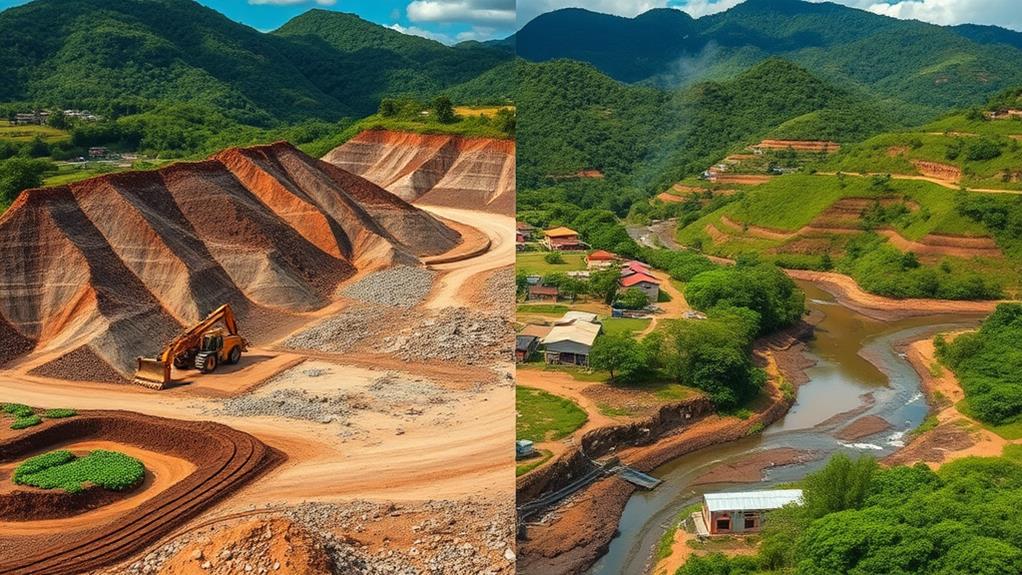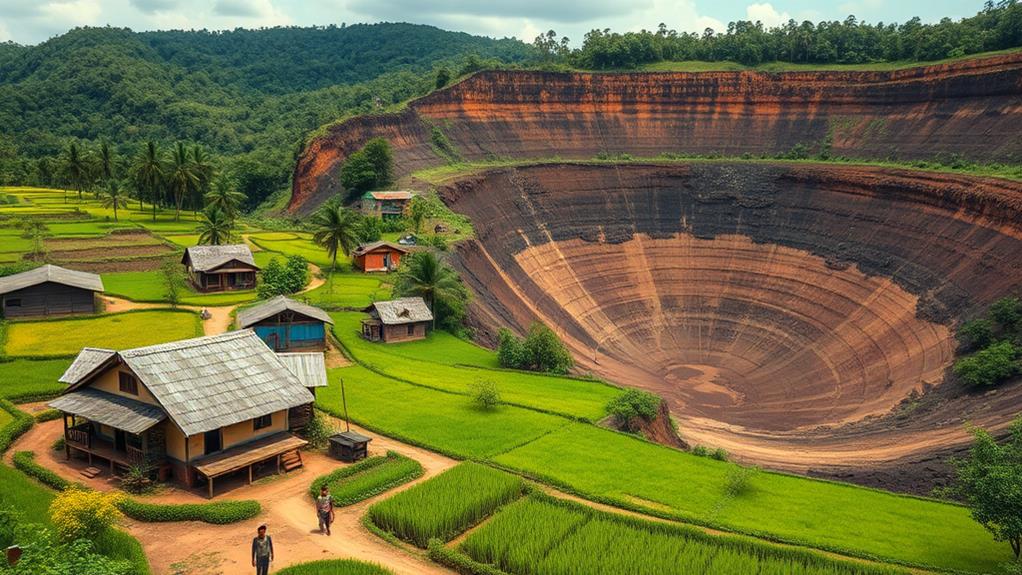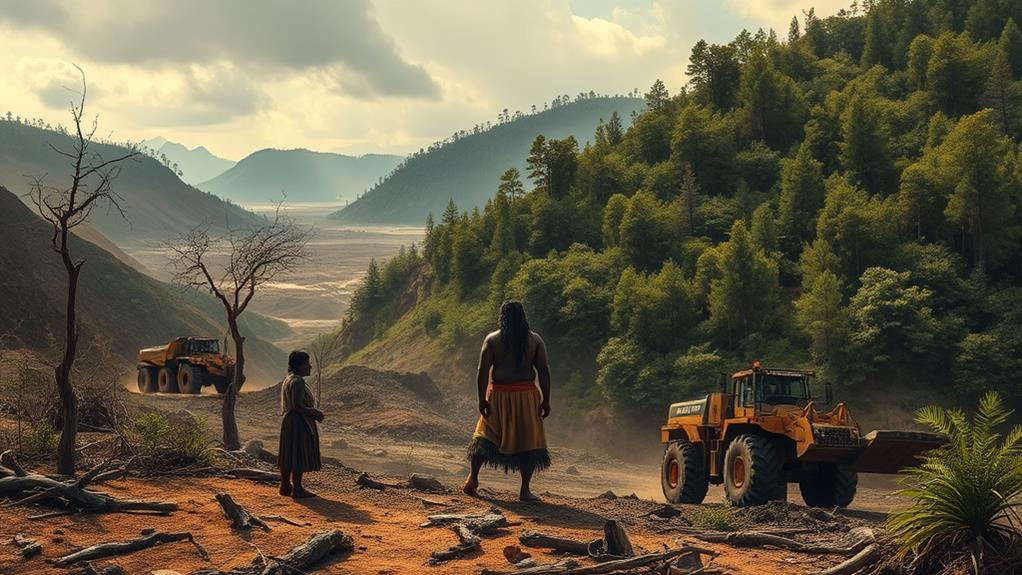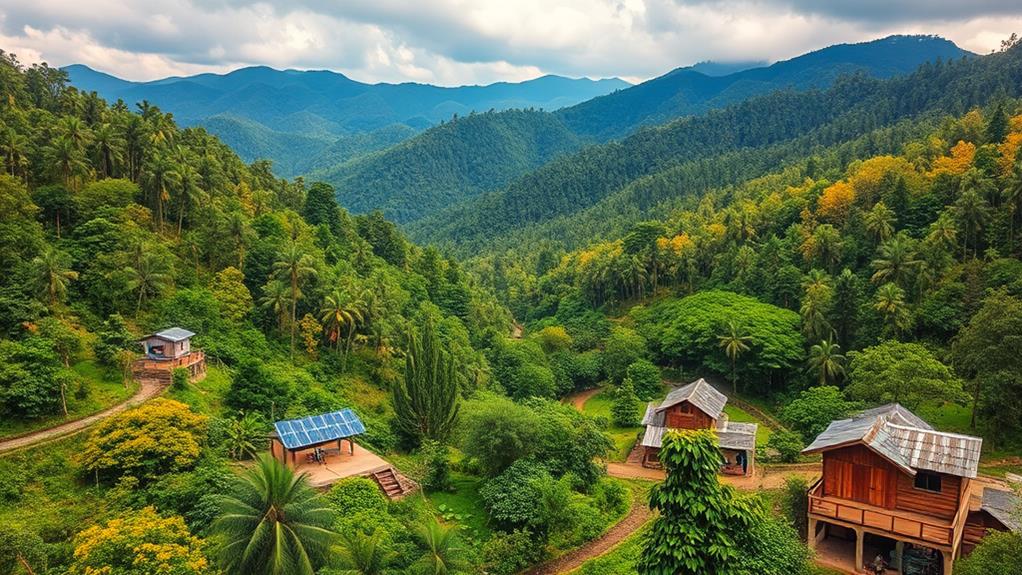Mining in the Philippines has negative effects on local communities and the environment. One major issue is deforestation, which occurs when trees are cut down for mining operations. This leads to biodiversity loss, meaning many plants and animals lose their habitats. Open-pit mining is a common method that causes this destruction.
Another serious problem is that indigenous families are displaced. These families often lose their homes and land without giving their consent. While mining only contributes less than 1% to the national GDP, it worsens poverty and health issues for people living nearby.
Additionally, local water sources often become contaminated due to mining activities. This creates long-term health risks for communities.
There are also human rights concerns, as many environmental defenders face violence for protecting their land.
There is an urgent need for sustainable mining practices and corporate accountability to address these issues.
Overview of Mining Practices

Mining practices in the Philippines show a major problem. The country has about $1 trillion in untapped mineral wealth, but mining contributes less than 1% to the national GDP. This raises concerns about the effectiveness and ethics of current mining operations.
Open-pit mining, which has recently been allowed again, is harmful to the environment. It leads to deforestation and loss of biodiversity. Indigenous communities are often affected the most. For example, the Tampakan project displaced over 1,000 Indigenous families, showing a lack of respect for their rights.
There's also a problem with Free, Prior, and Informed Consent (FPIC), as local populations often don't give their approval before mining begins.
The issues caused by mining aren't just environmental. The Philippines is the most dangerous country for environmental defenders, with 43 deaths linked to mining-related violence in 2019. This alarming situation highlights the need for a more responsible approach to mining that prioritizes the well-being of local communities and the environment over profit.
Environmental Degradation Effects
Mining in the Philippines causes serious harm to the environment. Here are some key facts:
- 1,580 hectares of forest have been cut down for nickel mining on Sibuyan Island.
- The Marcopper disaster released toxic waste, affecting 20,000 people.
- Acid mine drainage (AMD) contaminates water, harming fish and other wildlife.
- Heavy metals from mining waste create long-term health risks for local communities.
These mining activities lead to environmental damage that can last forever.
Deforestation disrupts local ecosystems and reduces biodiversity. Open-pit mining makes water contamination worse, as AMD releases toxic substances into rivers and lakes. This creates lasting toxicity that affects both wildlife and drinking water for people nearby.
Additionally, heavy metals from mining waste can remain in the environment for hundreds of years. This poses ongoing health risks and affects farmland.
Local communities often face a cycle of environmental harm that threatens their health and jobs. It's important to understand these serious effects and advocate for sustainable practices that protect the environment and support the well-being of affected communities.
Socioeconomic Impacts on Communities

Mining has a significant negative impact on the socioeconomic landscape of communities in the Philippines. Despite its potential, the mining sector contributes less than 1% to the country's GDP, showing a gap between expected benefits and actual results.
Indigenous communities suffer greatly, with over 1,000 families displaced by projects like the Tampakan mine, losing their homes and livelihoods.
Mining operations can harm local health, as they often contaminate air and water. This increases the risk of diseases such as hypertension and lung cancer.
Instead of bringing prosperity, mining often worsens existing inequalities, pushing many people deeper into poverty and causing conflicts over land use.
Economic benefits from mining rarely reach local communities. Many residents don't receive fair compensation or have alternative job options.
Civic freedoms are also reduced, making it hard for communities to voice their concerns about mining projects.
Human Rights Concerns
Mining activities in the Philippines raise serious human rights concerns. There are high rates of violence against environmental defenders, with 43 deaths in mining-related violence recorded in 2019, making the Philippines the most dangerous place for these activists.
Indigenous communities often face displacement without Free, Prior, and Informed Consent (FPIC), with reports indicating that over 1,000 Indigenous families have been forced from their lands.
Furthermore, there's an increase in human rights abuses linked to nickel extraction. Activists, especially women and Indigenous individuals, are facing more violence as they oppose mining projects.
While companies claim that mining brings economic benefits, these benefits rarely reach the local communities, leading to widening inequalities.
It is essential to hold corporations accountable to protect human rights and ensure that local communities aren't harmed for profit.
Change is urgent, and silence on these issues makes one complicit.
Indigenous Rights and Land Displacement

Mining projects in the Philippines promise economic growth, but they often harm Indigenous communities. Over 1,000 Indigenous families have been displaced due to projects like the Tampakan mine. This displacement breaks their connection to their ancestral lands. Mining operations frequently proceed without Free, Prior, and Informed Consent (FPIC), meaning there is often no real consultation with these communities.
| Impact | Indigenous Communities | Mining Corporations |
|---|---|---|
| Land Displacement | Over 1,000 families lost homes | Corporations gain profits |
| Economic Benefits | Minimal benefits for locals | Corporations increase wealth |
| Mining-related Violence | Women defenders are targeted | Corporations continue business |
The economic benefits claimed by mining companies do not reach local communities. These inequalities worsen Indigenous rights. Additionally, mining-related violence affects these communities, especially women who defend the environment. Although the Mining Act exists, it often does not protect Indigenous land rights. It is crucial to advocate for Indigenous rights and ensure their voices are included in decisions affecting their lives.
How Does Illegal Logging and Mining Impact Local Communities and the Environment in the Philippines?
Illegal logging in the Philippines poses significant challenges to local communities and the environment. The removal of trees without proper authorization leads to deforestation, soil erosion, and loss of biodiversity. Furthermore, the mining industry contributes to water pollution and habitat destruction, exacerbating the challenges of illegal logging.
Regulatory Framework and Challenges
The mining regulations in the Philippines are complicated and often fail to protect Indigenous rights and the environment. The 1996 Marcopper disaster led to changes in the Mining Act, but problems continue.
Local communities struggle to get Free, Prior, and Informed Consent (FPIC) before mining permits are issued. Recently, the lifting of the open-pit mining ban has raised concerns about more environmental damage. Community opposition is strong as local governments seek to cancel mining permits.
Although the Philippines is part of the Extractive Industries Transparency Initiative (EITI), there's still a lack of transparency and community involvement in mining.
The Department of Environment and Natural Resources (DENR) is criticized for not effectively enforcing environmental laws. This raises worries about its ability to protect ecosystems and communities.
Without real community involvement and respect for FPIC, the mining industry will keep harming the environment and violating Indigenous rights.
Reform and accountability are urgently needed to ensure that local communities are better protected and have a say in decisions that affect their land.
Pathways to Sustainable Mining

The mining industry in the Philippines can shift to sustainable practices that help local communities and protect the environment. This change requires community engagement and corporate accountability. Mining companies must listen to the needs of local people, including Indigenous groups, and ensure their operations do not harm the land.
| Sustainable Practices | Benefits to Communities |
|---|---|
| Responsible sourcing | Economic empowerment |
| Advocacy for environmental laws | Ecological preservation |
| Implementation of UN Principles | Protection of human rights |
For example, responsible sourcing means using materials that are obtained in a way that does not damage the environment. This helps create economic opportunities for local workers. By advocating for environmental laws, mining companies can help protect natural resources, leading to healthier ecosystems. Lastly, following UN Principles ensures that the human rights of local communities are respected.
Questions and Answers
How Does Mining Affect the Environment in the Philippines?
Mining negatively affects the environment in the Philippines. It causes water pollution when harmful chemicals from mining sites mix with rivers and lakes, making water unsafe for drinking and harming aquatic life. Mining also leads to deforestation, which means cutting down trees that are essential for clean air and wildlife habitats. This loss of trees contributes to biodiversity loss, where many plant and animal species may disappear.
Additionally, mining activities exacerbate soil degradation by disturbing the land and making it less fertile. The dust and particles released during mining operations can worsen air quality, leading to health problems for nearby communities. Furthermore, poor waste management from mining sites adds to climate change by releasing greenhouse gases and can destroy natural habitats for many species.
How Does Mining Affect Local Communities?
Mining has both positive and negative effects on local communities. It can provide economic benefits and create job opportunities. For example, a new mine may hire local workers, leading to more income for families. However, mining can also lead to social conflicts and health risks. Sometimes, different groups in the community may argue over resources or land use. Additionally, mining activities can pollute the air and water, which can harm people's health.
Furthermore, mining threatens cultural heritage. For instance, mining operations may destroy historical sites or areas that are important to local traditions. This can lead to a loss of identity for community members. Although mining can improve infrastructure, like roads and schools, it may hinder true community development. The focus on mining might shift attention away from other important needs, such as healthcare or education. Overall, while mining can bring some benefits, it also poses significant challenges for local communities.
What Are the Impacts of Mining on the Local Area?
Mining has both positive and negative impacts on local areas. The economic benefits can be significant for some people, such as job creation and increased local business revenue. For example, mining companies often hire local workers and purchase supplies from nearby stores.
However, mining also leads to serious problems. One major issue is land degradation, where the landscape is damaged due to excavation and removal of soil. This can make it difficult for plants to grow. Another concern is water pollution, which occurs when harmful chemicals from mining operations enter rivers and lakes, affecting drinking water and aquatic life.
Biodiversity loss is another impact, as mining can destroy habitats for many species. For instance, when forests are cleared for mining, animals lose their homes. Additionally, community displacement happens when people are forced to leave their homes due to mining activities. This can disrupt families and their way of life.
Health risks are also associated with mining. Workers may be exposed to hazardous materials, and nearby residents can suffer from pollution-related illnesses. Lastly, mining can threaten cultural heritage by damaging sites that are important to local communities.
What Are 4 Impacts of Mining on the Environment?
Mining has severe impacts on the environment. First, it causes water pollution. For example, chemicals used in mining can leak into rivers and lakes, harming fish and other wildlife.
Second, mining leads to deforestation. Large areas of forests are cut down to make space for mining operations, which destroys habitats for many animals.
Third, mining results in soil degradation. The land becomes less fertile, making it hard for plants to grow. This can affect local agriculture and food supply.
Lastly, mining can disrupt ecosystems. It often leads to biodiversity loss. For instance, when a habitat is destroyed, species that rely on that habitat may become endangered or extinct.